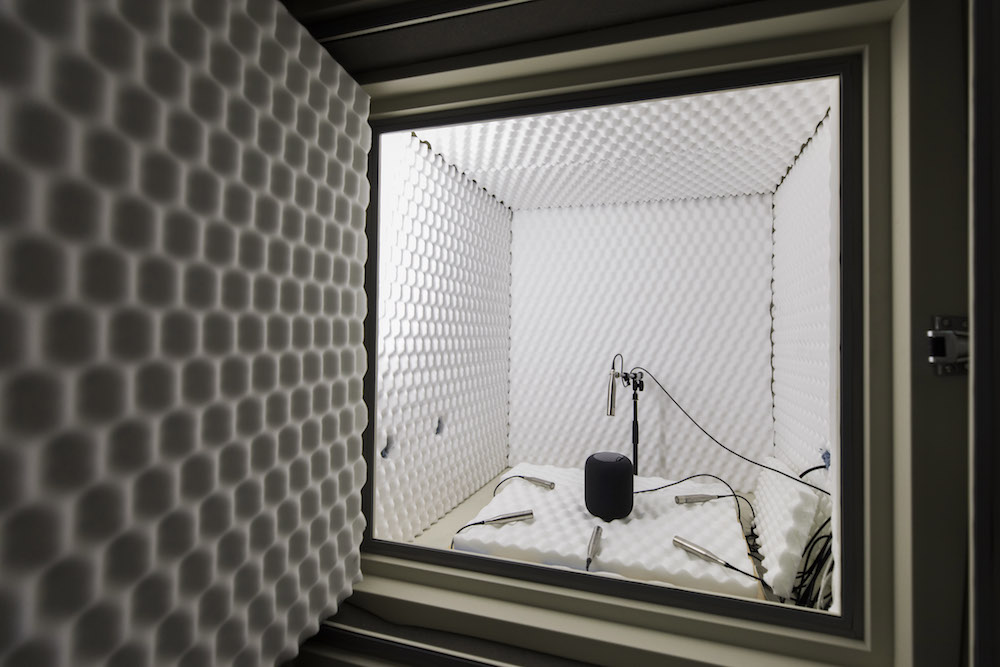
There are still a few days to go before the official launch of the HomePod, scheduled for next Friday (9/2), but that doesn’t mean that the first smart speaker from Apple is no longer being tantalized left and right by analyzes around the world (ours, as we could not let to be, will arrive soon). More than that: even Apple itself opened the doors of its top-secret acoustic laboratory to show details of the development of HomePod to some lucky journalists.
At the The LoopJim Dalrymple describes the facility as home to all aspects of audio at Apple. As her senior vice president of global marketing Phil Schiller says, everything – from the speaker on iPhones, iPads and Macs to AirPods, through Siri and microphone capture – goes on several times, prototype by prototype, for these acoustic chambers built in the basement of an undisclosed building in Cupertino.

Apple’s senior director of audio engineering and design, Gary Geaves, claims that Apple possibly set up “the world’s largest audio and acoustic team,” while showing the journalist a fully disassembled HomePod, revealing the company’s care in building the product from scratch, with all its components designed internally, instead of simply taking parts here and there from suppliers and assembling something similar to what the market already knows. Even the fabric covering the product was developed by Apple to guarantee maximum acoustic transparency and, at the same time, conform to all other company standards.
As for the acoustic chambers themselves, Apple offered access to three of them: the main one is the anechoic chamber, built inside another room and supported by insulating springs to basically eliminate any vibrations or external noise – it was there that Apple developed all directional sound part of the HomePod. There is also a specific camera for the voice detection test, which applies varied reverberation effects so that the products can capture “Hey there, Siri” in any circumstance.

Finally, the third chamber is responsible for detecting electronic noise – that is, so weak that the silence there needs to be absolute. Therefore, the space is over 28 tonnes of concrete and is surrounded by 30cm walls, with more than 80 insulating pieces to create an environment whose sound reaches -2dBA – an index below human audible capacity, that is, absolute silence. . This camera was originally built for Apple to detect unwanted noise on Macs, but has since expanded to (many) other uses, such as in the development of AirPods.
· • ·
THE TechCrunch, in turn, was one of the first specialized vehicles to post its impressions about the HomePod and, with them, we gained some more information about the product and its technologies – which can comprehend bigger or smaller details. For example: the review praises the speaker cable, which, although embedded in the device, is covered with a fabric and made in a way that is extremely malleable even though it is relatively thick, allowing it to be hidden or adapted to any position.

What’s more, despite having its sound highly praised and compared positively with all competitors in the same price range, the reviews agree that the speaker does not produce enough volume to fill a house or a very large room. For this, Apple will release a function called FullRoom, different from the one already announced MultiRoom – in it, two HomePods will work in unison in the same environment, without stereo separation; they will only identify their spatial positions and make the music sound identical across the room. This feature will arrive soon, before the MultiRoomsays the website.
THE FullRooom it is just another feature within all the technology – according to those who have already tested it, extremely accurate – of spatial detection of HomePod. I must say that even though I have no intention of having Apple’s new cotton ball at home (all reviews agree that its full capabilities are only used with Apple Music and the total immersion in the Apple ecosystem, which I am not willing to to practice), I’m curious to test the bug and its so-called intelligence.
Coverage of HomePod launch
Thanks to Go Imports, The MacMagazine will provide full coverage of the launch of HomePod, putting hands on the product on February 9 and bringing, first hand, videos and articles about everything that permeates the first generation of this new Apple product.

Stay tuned that good stuff is coming! ?
